Pierre Soulages
(Rodez 1919 - 2022 Nîmes)
"Eau-forte XX"
Farbaquatintaradierung 1972
50 x 66 cm, Pr. 33 x 44 cm
sign. num.
Auflage ca. 100 Exemplare
Encrevé/Miessner Kat. Nr. 21
[25776]
We cordially invite you to a virtual tour of our exhibitions "PIERRE SOULAGES":
The exhibition takes place with the kind support of musée soulages, Rodez.
"In the graphic print medium, I find another dimension of my artistic expression, where I can explore the depth of matter and experiment with the interplay of structures."
Pierre Soulages
Pierre Soulages
(Rodez 1919 - 2022 Nîmes)
"Eau-forte XX"
Farbaquatintaradierung 1972
50 x 66 cm, Pr. 33 x 44 cm
sign. num.
Auflage ca. 100 Exemplare
Encrevé/Miessner Kat. Nr. 21
[25776]
On the occasion of the 185th anniversary of the gallery
and the "DüSSELDORF COLOGNE OPEN GALLERIES 2023"
(01.–03.09.2023)
PIERRE SOULAGES
(Rodez 1919 – 2022 Nîmes)
"Hommage à Pierre Soulages"
– Selected prints
Pierre Soulages
(Rodez 1919 - 2022 Nîmes)
"Eau-forte Xa"
Farbaquatintaradierung 1957
76 x 56,5 cm, Pr. 59,4 x 43,5 cm
sign. num.
Auflage ca. 100 Exemplare
Encrevé/Miessner Kat. Nr. 10
[22683]
We cordially invite you and your friends to our opening
on Friday, the 1st of September 2023, in the time between 6:00 p.m. and 9:00 p.m.
The exhibition will be accompanied by a fully illustrated catalogue (96 pages, text: Benoit Decron, Director of the musée Soulages, Rodez, Euro 10).
You also have the possibility to leaf through the cataloque (PDF) virtually here.
Special opening hours during
"DüSSELDORF COLOGNE OPEN GALLERIES 2023":
Friday 01 September 2023 6 p.m.–9 p.m.
Saturday 02 September 2023 1 p.m.–7 p.m.
Sunday 03 September 2023 1 p.m.–5 p.m.
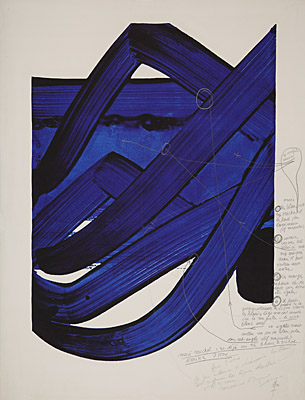
Pierre Soulages
(Rodez 1919 - 2022 Nîmes)
"Sérigraphie No. 18"
Farbsiebdruck 1988
89 x 68,2 cm, Abb. 75,5 x 54,2 cm
sign. bez.
Auflage ca. 600 Exemplare
Encrevé/Miessner Kat. Nr. 110
[25121]
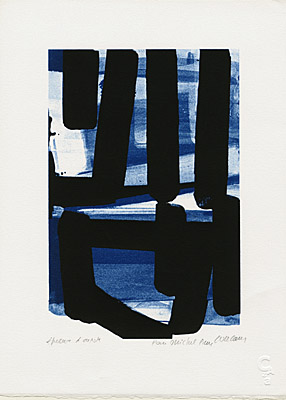
Pierre Soulages
(Rodez 1919 - 2022 Nîmes)
"Sérigraphie No. 27"
Farbsiebdruck 2003
30 x 22 cm, Abb. 22 x 14,7 cm
sign. bez.
Encrevé/Miessner Kat. Nr. 119
[25128]
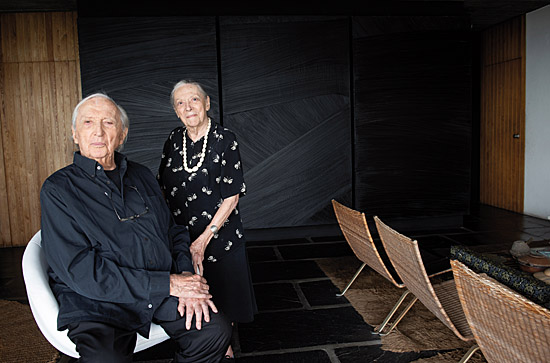
Pierre und Colette Soulages, Sète 2019
© photo : Virginie Clavières / Paris Match / Scoop
PIERRE SOULAGES
"Hommage à Pierre Soulages - Selected Works from the Graphic Œuvre"
Works from Pierre Soulages's graphic oeuvre have been part of Galerie Boisserée's exhibition repertoire for many years. Through close personal contact with the artist, extensive exhibitions and accompanying publications were already realized in 2009 and 2014. On the occasion of its 185th anniversary, the Galerie Boisserée is delighted to open the 2023/2024 exhibition season with the largest retrospective of Pierre Soulages's graphic works to date.
Soulages's graphic oeuvre is small, which makes it all the more difficult to assemble a representative collection of his works. Over the past ten years, however, we have succeeded in building a coherent collection that represents nearly half of Pierre Soulages's graphic oeuvre.
With the largest exhibition of his graphic works currently on the European art market, Galerie Boisserée offers collectors and art enthusiasts a concentrated insight into the artistic achievements of the great French artist. The exhibition includes aquatint etchings, lithographs, and silkscreen prints, representing all the techniques Soulages used to realize his motifs.
"In fact, I work with great passion in both engraving and painting. When I'm passionate about something, I devote myself exclusively to it. I literally have attacks of lithography, I have attacks of etching, just as I have attacks of painting." (Pierre Soulages, quoted in Encrevé, p. 44).
Pierre Soulages (1919–2022) is one of the most important French artists of the twentieth century. Over the course of his long career, he developed a unique body of paintings. Based on the non-color black, he succeeded in depicting the effects of light on his canvases in many different ways. In addition to his painting, he also worked in printmaking. His aquatint etchings, lithographs, and silkscreen prints are characterized by moments of chance and experimentation. He uses embossing to create a tactile, haptic structure in his dynamic compositions and forms. The motifs are imbued with gestural spontaneity and the tension between condensed areas and empty spaces. As in his paintings, this creates a play of light and dark.
On October 25, 2022, Pierre Soulages passed away at the age of 102. On November 2, 2022, the French state paid tribute to his life and work in a memorial ceremony held at the Cour Carrée of the Louvre in Paris.
The exhibition will open on Friday, September 1, 2023, as part of the DC Open gallery weekend and will be on view at Galerie Boisserée through October 21, 2023. A catalog will be published in conjunction with the exhibition and will be available for purchase at the gallery and online.
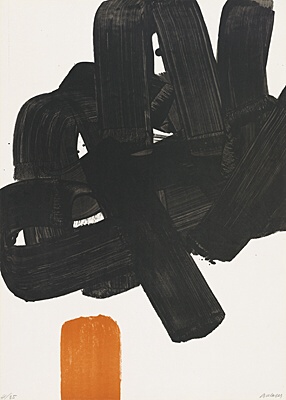
Pierre Soulages
(Rodez 1919 - 2022 Nîmes)
"Lithographie No. 24 b"
Farblithographie 1969
78,8 x 56 cm
sign. num.
Auflage ca. 85 Exemplare
Encrevé/Miessner Kat. Nr. 72
[22627]
Press release (French, en français).
Pierre Soulages
(Rodez 1919 - 2022 Nîmes)
"Eau-forte IX"
Farbaquatintaradierung 1957
66 x 50,3 cm, Pr. 55 x 39 cm
sign. num.
Auflage ca. 100 Exemplare
Encrevé/Miessner Kat. Nr. 9
[23805]
The gallery will participate in HIGHLIGHTS 2023 International Art Fair in the Munich Residence from Wednesday, the 18th of October until Sunday, the 22nd of October 2023.
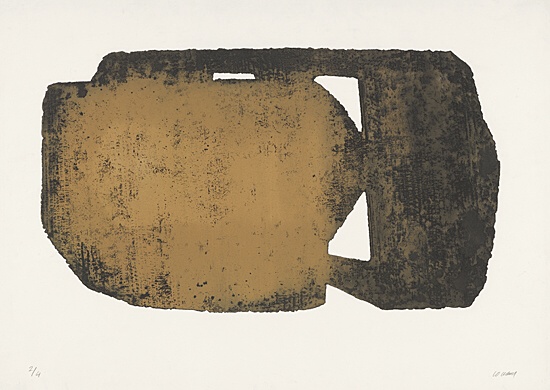
Pierre Soulages
(Rodez 1919 - 2022 Nîmes)
"Eau-forte XXXVI a"
Farbaquatintaradierung 1979
74,8 x 105,6 cm, Pr. 50 x 87 cm
sign. num.
Auflage 6 Exemplare
noch nicht bei Encrevé/Miessner
Es gibt von diesem Blatt nur vier signierte und nummerierte Abzüge und zwei Probeabzüge als Farbvarianten.
[23858]
COME IN AND EXPLORE THE ARTWORKS OF OUR EXHIBITION:
PIERRE SOULAGES
"Hommage à PIERRE SOULAGES"
– Arbeiten aus dem graphischen Œuvre
Please see all of the works from the exhibition here:
Pierre Soulages
(Rodez 1919 - 2022 Nîmes)
"Eau-forte II"
Farbaquatintaradierung 1952
50,3 x 66,2 cm, Pr. 38 x 55,5 cm
sign. num.
Auflage ca. 100 Exemplare
Encrevé/Miessner Kat. Nr. 2
[24256]
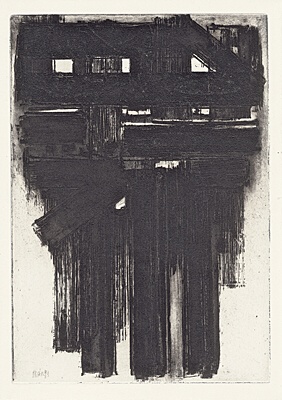
Pierre Soulages
(Rodez 1919 - 2022 Nîmes)
"Eau-forte III"
Aquatintaradierung 1956
26,7 x 19,3 cm, Pr. 24,6 x 17,3 cm
num.
Auflage 600 Exemplare
Encrevé/Miessner Kat. Nr. 3
[16719]
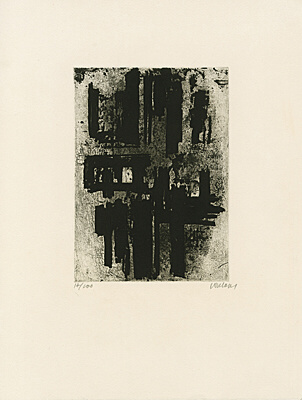
Pierre Soulages
(Rodez 1919 - 2022 Nîmes)
"Eau-forte IV"
Aquatintaradierung 1957
33 x 25,2 cm, Pr. 17,5 x 12,7 cm
sign. num.
Auflage 100 Exemplare
Encrevé/Miessner Kat. Nr. 4
[23448]
Pierre Soulages
(Rodez 1919 - 2022 Nîmes)
"Eau-forte IX"
Farbaquatintaradierung 1957
66 x 50,3 cm, Pr. 55 x 39 cm
sign. num.
Auflage ca. 100 Exemplare
Encrevé/Miessner Kat. Nr. 9
[23805]
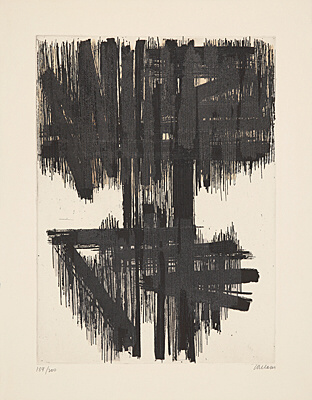
Pierre Soulages
(Rodez 1919 - 2022 Nîmes)
"Eau-forte VI"
Farbaquatintaradierung 1957
73 x 56,8 cm, Pr. 59,5 x 43,3 cm
sign. num.
Auflage ca. 200 Exemplare
Encrevé/Miessner Kat. Nr. 6
[23447]
Pierre Soulages
(Rodez 1919 - 2022 Nîmes)
"Eau-forte VIII"
Farbaquatintaradierung 1957
75,5 x 56,5 cm, Pr. 59 x 43,5 cm
sign. num.
Auflage ca. 100 Exemplare
Encrevé/Miessner Kat. Nr. 8
[22548]
Pierre Soulages
(Rodez 1919 - 2022 Nîmes)
"Eau-forte Xa"
Farbaquatintaradierung 1957
76 x 56,5 cm, Pr. 59,4 x 43,5 cm
sign. num.
Auflage ca. 100 Exemplare
Encrevé/Miessner Kat. Nr. 10
[22683]
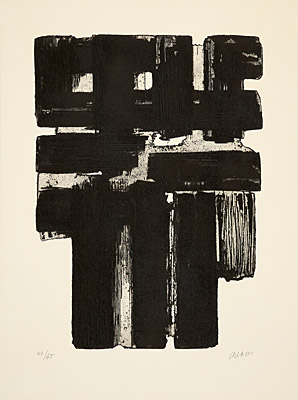
Pierre Soulages
(Rodez 1919 - 2022 Nîmes)
"Eau-forte Xb"
Aquatintaradierung 1957
75,8 x 43,4 cm, Pr. 59,5 x 43,5 cm
sign. num.
Auflage ca. 65 Exemplare
Encrevé/Miessner Kat. Nr. 11
[22407]
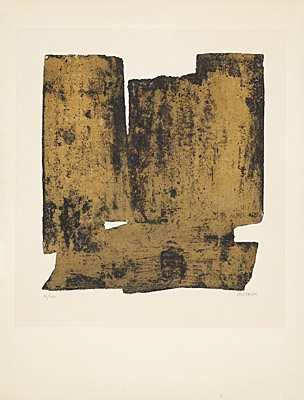
Pierre Soulages
(Rodez 1919 - 2022 Nîmes)
"Eau-forte XII"
Farbaquatintaradierung 1957
65,6 x 50 cm, Pr. 39,5 x 36 cm
sign. num.
Auflage ca. 100 Exemplare
Encrevé/Miessner Kat. Nr. 13
[22747]
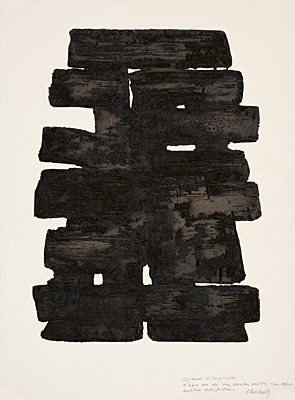
Pierre Soulages
(Rodez 1919 - 2022 Nîmes)
"Eau-forte XIII"
Farbaquatintaradierung 1957
76 x 56,5 cm, Pr. 59,5 x 43,5 cm
sign. bez.
Auflage ca. 110 Exemplare
Encrevé/Miessner Kat. Nr. 14
[22779]
Pierre Soulages
(Rodez 1919 - 2022 Nîmes)
"Lithographie No. 3"
Farblithographie 1957
71 x 50,5 cm, Abb. 63 x 48 cm
sign. num.
Auflage ca. 200 Exemplare
Encrevé/Miessner Kat. Nr. 46
[23603]
Pierre Soulages
(Rodez 1919 - 2022 Nîmes)
"Lithographie No. 5"
Farblithographie 1957
64,6 x 50 cm, Abb. 57,5 x 43 cm
sign. num.
Auflage ca. 65 Exemplare
Encrevé/Miessner Kat. Nr. 48
[23514]
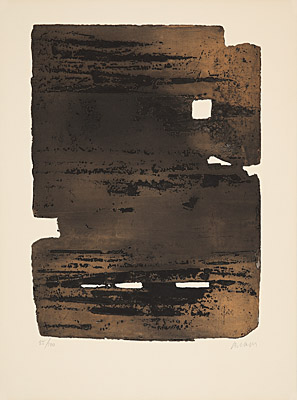
Pierre Soulages
(Rodez 1919 - 2022 Nîmes)
"Eau-forte XV"
Farbaquatintaradierung 1961
76 x 57 cm, Pr. 59,8 x 43,5 cm
sign. num.
Auflage ca. 110 Exemplare
Encrevé/Miessner Kat. Nr. 16
[21884]
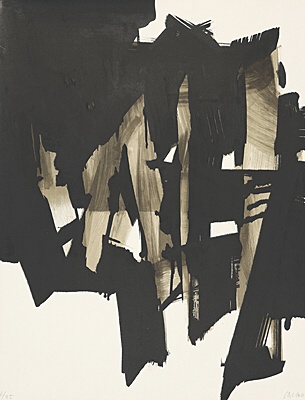
Pierre Soulages
(Rodez 1919 - 2022 Nîmes)
"Lithographie No. 15"
Farblithographie 1964
65,5 x 50 cm
sign. num.
Auflage ca. 85 Exemplare
Encrevé/Miessner Kat. Nr. 61
[20794]
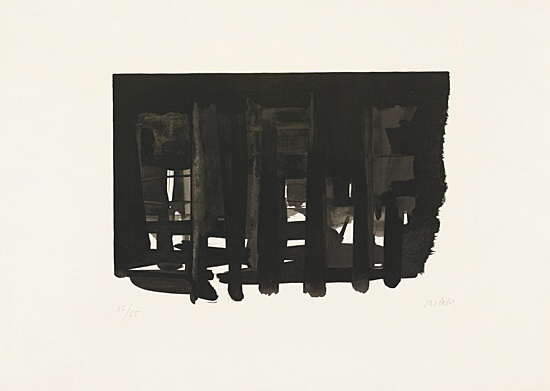
Pierre Soulages
(Rodez 1919 - 2022 Nîmes)
"Lithographie No. 16"
Farblithographie 1964
54,5 x 76,2 cm, Abb. 32 x 46,5 cm
sign. num.
Auflage ca. 65 Exemplare
Encrevé/Miessner Kat. Nr. 62
[24044]
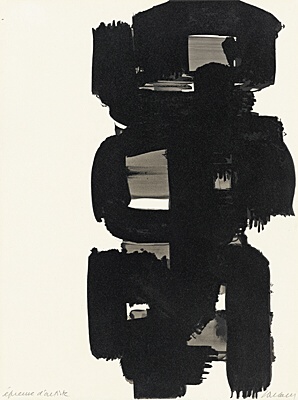
Pierre Soulages
(Rodez 1919 - 2022 Nîmes)
"Lithographie No. 18"
aus "La peau des choses" (Michel Ragon)
Farblithographie 1968
50,5 x 37,7 cm, Abb. 50 x 25,7 cm
sign.
Auflage ca. 120 Exemplare
Encrevé/Miessner Kat. Nr. 64
[22822]
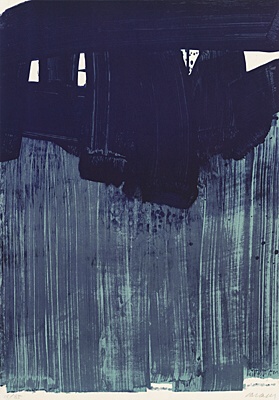
Pierre Soulages
(Rodez 1919 - 2022 Nîmes)
"Lithographie No. 23"
Farblithographie 1969
79,5 x 55,7 cm, Abb. 78 x 55,7 cm
sign. num.
Auflage ca. 85 Exemplare
Encrevé/Miessner Kat. Nr. 70
[23109]

Pierre Soulages
(Rodez 1919 - 2022 Nîmes)
"Lithographie No. 24 b"
Farblithographie 1969
78,8 x 56 cm
sign. num.
Auflage ca. 85 Exemplare
Encrevé/Miessner Kat. Nr. 72
[22627]
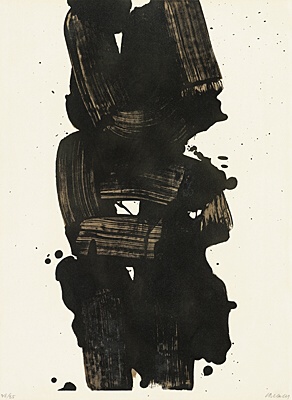
Pierre Soulages
(Rodez 1919 - 2022 Nîmes)
"Lithographie No. 25"
Farblithographie 1969
78 x 57,5 cm, Abb. 76 x 37 cm
sign. num.
Auflage ca. 85 Exemplare
Encrevé/Miessner Kat. Nr. 73
[23127]
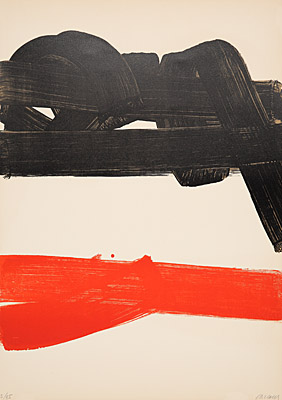
Pierre Soulages
(Rodez 1919 - 2022 Nîmes)
"Lithographie No. 27"
Farblithographie 1969
79 x 55,9 cm
sign. num.
Auflage ca. 85 Exemplare
Encrevé/Miessner Kat. Nr. 75
[22227]
Pierre Soulages
(Rodez 1919 - 2022 Nîmes)
"Eau-forte XX"
Farbaquatintaradierung 1972
50 x 66 cm, Pr. 33 x 44 cm
sign. num.
Auflage ca. 100 Exemplare
Encrevé/Miessner Kat. Nr. 21
[25776]
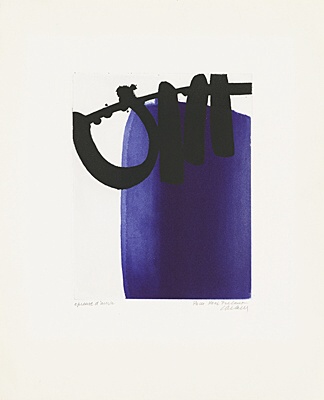
Pierre Soulages
(Rodez 1919 - 2022 Nîmes)
"Eau-forte XXI"
Farbaquatintaradierung 1972
47,2 x 37,5 cm, Pr. 26,5 x 21 cm
sign. bez.
Auflage ca. 115 Exemplare
Encrevé/Miessner Kat. Nr. 22
[23460]
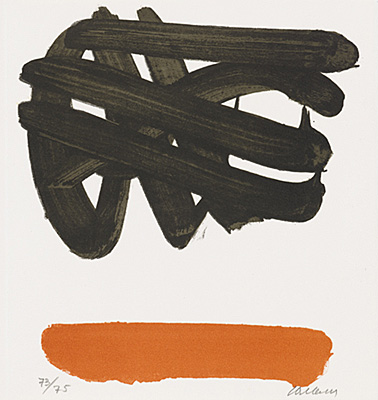
Pierre Soulages
(Rodez 1919 - 2022 Nîmes)
"Lithographie No. 30"
Farblithographie 1972
29 x 27 cm, Abb. 27,5 x 24,5 cm
sign. num.
Auflage ca. 75 Exemplare
Encrevé/Miessner Kat. Nr. 78
[23560]
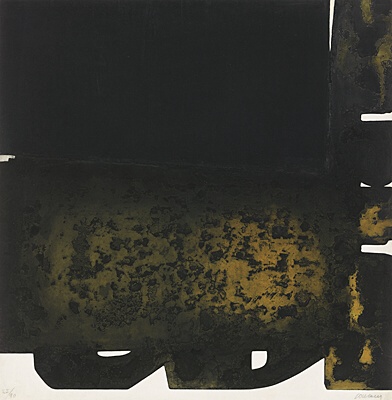
Pierre Soulages
(Rodez 1919 - 2022 Nîmes)
"Eau-forte XXII"
Farbaquatintaradierung 1973
96 x 94 cm, Pr. 92,3 x 94 cm
sign. num.
Auflage ca. 90 Exemplare
Encrevé/Miessner Kat. Nr. 23
[23104]
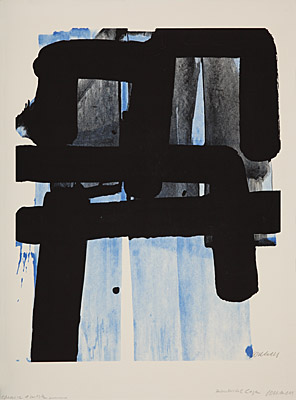
Pierre Soulages
(Rodez 1919 - 2022 Nîmes)
"Sérigraphie No. 2"
Farbsiebdruck 1973
75,4 x 55,9 cm, Abb. 63 x 50,5 cm
sign. bez.
Auflage 235 Exemplare
Encrevé/Miessner Kat. Nr. 94
[24904][25119]
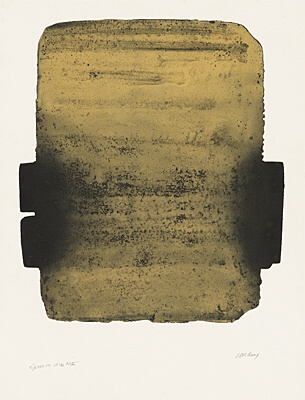
Pierre Soulages
(Rodez 1919 - 2022 Nîmes)
"Eau-forte XXIX"
Farbaquatintaradierung 1974
65,5 x 50,3 cm, Pr. 49 x 43 cm
sign. bez.
Auflage ca. 105 Exemplare
Encrevé/Miessner Kat. Nr. 31
[23859]
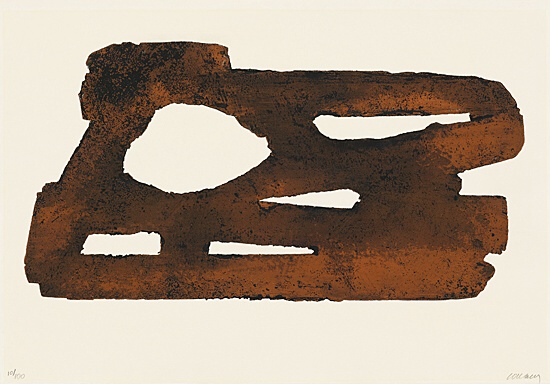
Pierre Soulages
(Rodez 1919 - 2022 Nîmes)
"Eau-forte XXVII"
Farbaquatintaradierung 1974
53 x 75,3 cm, Pr. 35 x 69 cm
sign. num.
Auflage ca. 100 Exemplare
Encrevé/Miessner Kat. Nr. 29
[22672]
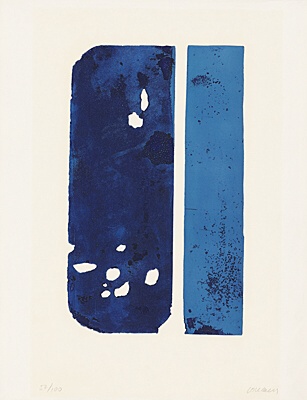
Pierre Soulages
(Rodez 1919 - 2022 Nîmes)
"Eau-forte XXX"
Farbaquatintaradierung 1974
65,5 x 50,3 cm, Pr. 47 x 29 cm
sign. num.
Auflage ca. 100 Exemplare
Encrevé/Miessner Kat. Nr. 32
[23785]
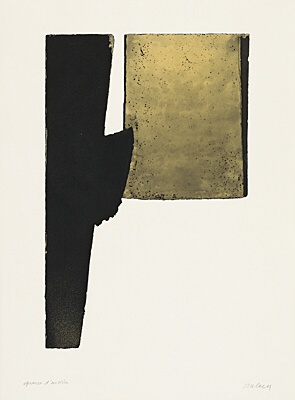
Pierre Soulages
(Rodez 1919 - 2022 Nîmes)
"Eau-forte XXXI"
Farbaquatintaradierung 1974
76,3 x 57 cm, Pr. 59,5 x 38,5 cm
sign. bez.
Auflage ca. 105 Exemplare
Encrevé/Miessner Kat. Nr. 33
[22954]
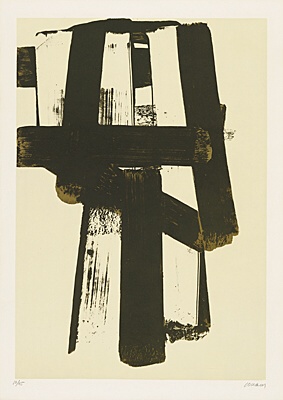
Pierre Soulages
(Rodez 1919 - 2022 Nîmes)
"Lithographie No. 31"
Farblithographie 1974
88 x 62,2 cm, Abb. 79,3 x 54,8 cm
sign. num.
Auflage ca. 100 Exemplare
Encrevé/Miessner Kat. Nr. 79
[23558]
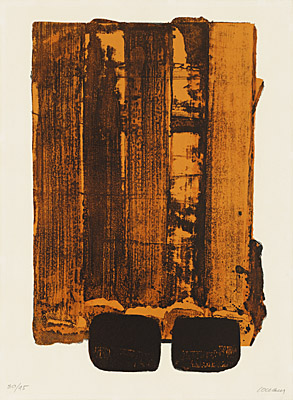
Pierre Soulages
(Rodez 1919 - 2022 Nîmes)
"Lithographie No. 34"
Farblithographie 1974
67,7 x 50 cm, Abb. 60 x 40 cm
sign. num.
Auflage ca. 95 Exemplare
Encrevé/Miessner Kat. Nr. 83
[22737]
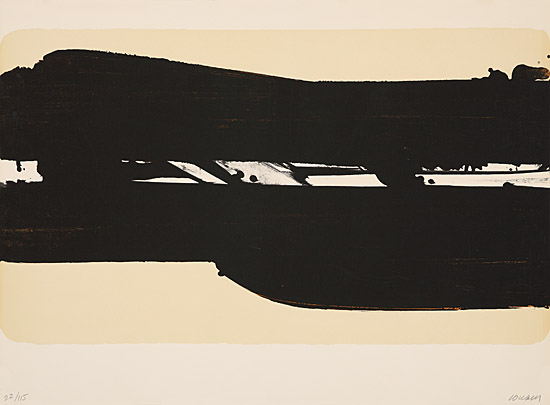
Pierre Soulages
(Rodez 1919 - 2022 Nîmes)
"Lithographie No. 39"
Farblithographie 1977
56,2 x 75,8 cm, Abb. 43,5 x 75,8 cm
sign. num.
Auflage ca. 115 Exemplare
Encrevé/Miessner Kat. Nr. 88
[22746]
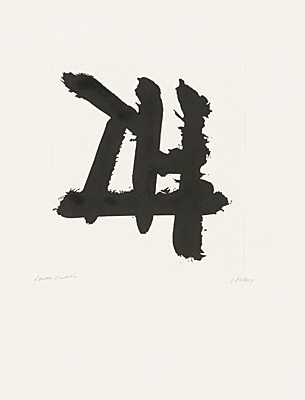
Pierre Soulages
(Rodez 1919 - 2022 Nîmes)
"Eau-forte XXXIV"
aus "Les Élégies majeures" (Léopold Sédar Senghor)
Aquatintaradierung 1978
42,7 x 32,7 cm, Pr. 22,5 x 20,8 cm
sign. bez.
Auflage ca. 250 Exemplare
Encrevé/Miessner Kat. Nr. 36
[23860][23013]
Pierre Soulages
(Rodez 1919 - 2022 Nîmes)
"Sérigraphie No. 8"
Farbsiebdruck 1978
58 x 46,7 cm, Abb. 45 x 34,5 cm
sign. bez.
Auflage ca. 60 Exemplare
Encrevé/Miessner Kat. Nr. 100
[24470]
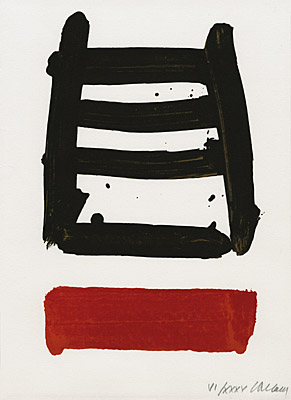
Pierre Soulages
(Rodez 1919 - 2022 Nîmes)
"Lithographie 40"
aus "Vingt-deux poèmes" (Cassou)
Farblithographie 1978
38,2 x 28 cm, Abb. 33 x 21 cm
sign. num.
Auflage ca. 150 Exemplare
Encrevé/Miessner Kat. Nr. 89
[27135]
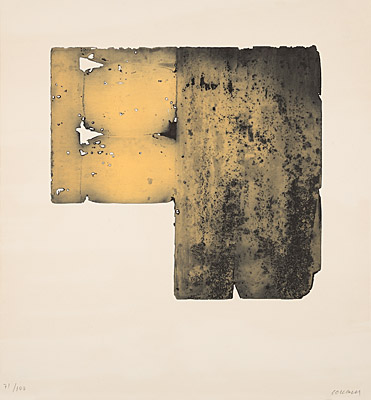
Pierre Soulages
(Rodez 1919 - 2022 Nîmes)
"Eau-forte XXXV"
Farbaquatintaradierung 1979
78 x 72,5 cm, Pr. 49,5 x 52,5 cm
sign. num.
Auflage ca. 100 Exemplare
Encrevé/Miessner Kat. Nr. 37
[22373]

Pierre Soulages
(Rodez 1919 - 2022 Nîmes)
"Eau-forte XXXVI a"
Farbaquatintaradierung 1979
74,8 x 105,6 cm, Pr. 50 x 87 cm
sign. num.
Auflage 6 Exemplare
Encrevé/Miessner Kat. Nr. vgl. 038
[23858]
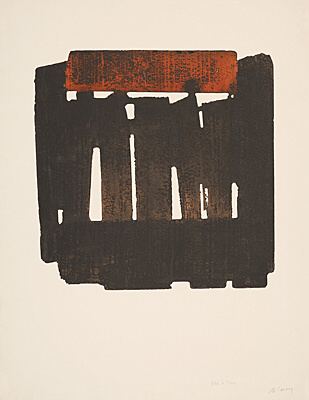
Pierre Soulages
(Rodez 1919 - 2022 Nîmes)
"Eau-forte XXXVI"
Farbaquatintaradierung 1979
85,8 x 67 cm, Pr. 51 x 51 cm
sign. bez.
Auflage ca. 110 Exemplare
Encrevé/Miessner Kat. Nr. 38
[22780]
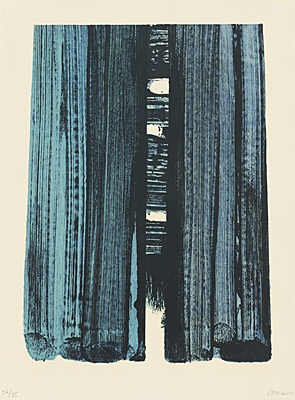
Pierre Soulages
(Rodez 1919 - 2022 Nîmes)
"Lithographie No. 42"
Farblithographie 1979
76 x 56,3 cm, Abb. 64,2 x 47,3 cm
sign. num.
Auflage 85 Exemplare
Encrevé/Miessner Kat. Nr. 91
[23803]
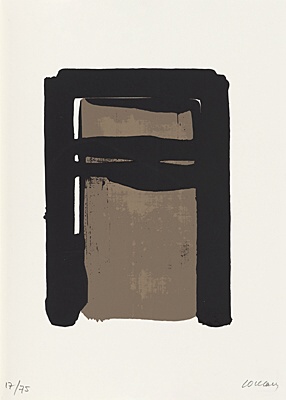
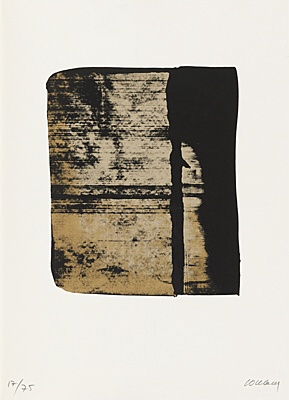
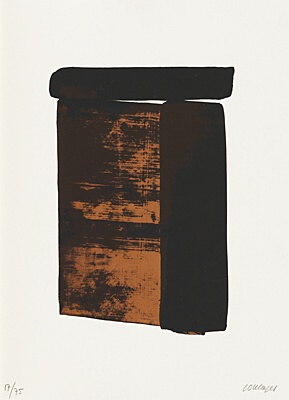
Pierre Soulages
(Rodez 1919 - 2022 Nîmes)
"Sur le mur d'en face"
(Auf der gegenüberliegenden Wand)
Mappenwerk mit 3 Farbsiebdrucken und einem Text von Pierre Soulages 1979
52,5 x 38 cm x 1,5 cm
sign. num.
Auflage 100 Exemplare
Encrevé/Miessner 102-104
[23419]
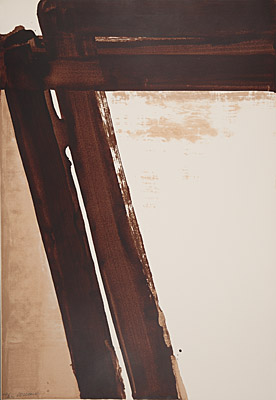
Pierre Soulages
(Rodez 1919 - 2022 Nîmes)
"Sérigraphie No. 15"
Farbsiebdruck 1981
105 x 72,5 cm, Abb. 104,5 x 72,3 cm
sign. num.
Auflage 295 Exemplare
Encrevé/Miessner Kat. Nr. 107
[24902]
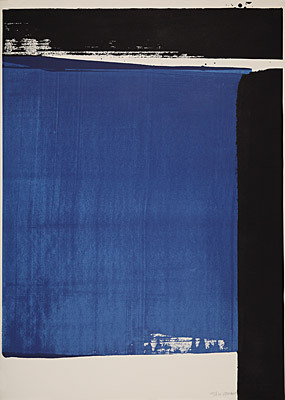
Pierre Soulages
(Rodez 1919 - 2022 Nîmes)
"Sérigraphie No. 16"
Farbsiebdruck 1981
105 x 74,5 cm, Abb. 104,5 x 73,5 cm
sign. num.
Auflage 295 Exemplare
Encrevé/Miessner Kat. Nr. 108
[24903]
Pierre Soulages
(Rodez 1919 - 2022 Nîmes)
"Sérigraphie No. 18"
Farbsiebdruck 1988
88,8 x 68,2 cm, Abb. 75,5 x 54 cm
sign. num.
Auflage ca. 600 Exemplare
Encrevé/Miessner Kat. Nr. 110
[24025]

Pierre Soulages
(Rodez 1919 - 2022 Nîmes)
"Sérigraphie No. 18"
Farbsiebdruck 1988
89 x 68,2 cm, Abb. 75,5 x 54,2 cm
sign. bez.
Auflage ca. 600 Exemplare
Encrevé/Miessner Kat. Nr. 110
Arbeitsexemplar des Druckers mit handschriftlichen Anmerkungen von Pierre Soulages.
[25121]
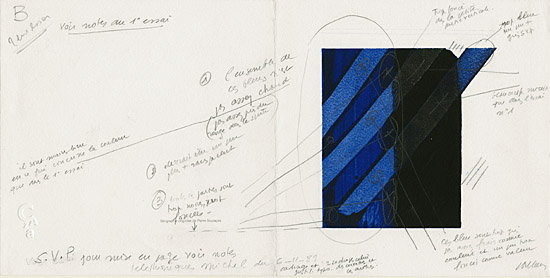
Pierre Soulages
(Rodez 1919 - 2022 Nîmes)
"Sérigraphie No. 17"
Probedruck A
Farbsiebdruck 1989
35,5 x 18 cm, Abb. 11,5 x 11,3 cm
sign.
Encrevé/Miessner Kat. Nr. 109
Arbeitsexemplar des Druckers mit handschriftlichen Anmerkungen von Pierre Soulages.
[25120]
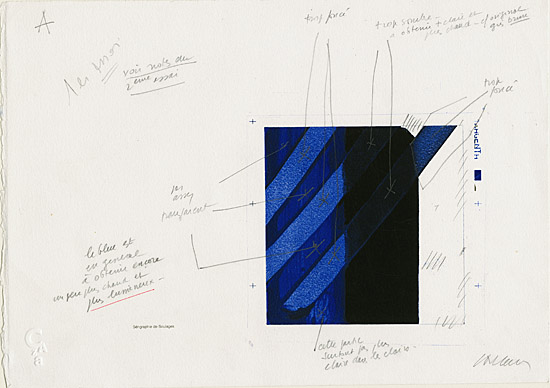
Pierre Soulages
(Rodez 1919 - 2022 Nîmes)
"Sérigraphie No. 17"
Probedruck B
Farbsiebdruck 1989
31,8 x 22,7 cm, Abb. 11,5 x 11,3 cm
sign.
Encrevé/Miessner Kat. Nr. 109
[25126]
Arbeitsexemplar des Druckers mit handschriftlichen Anmerkungen von Pierre Soulages.
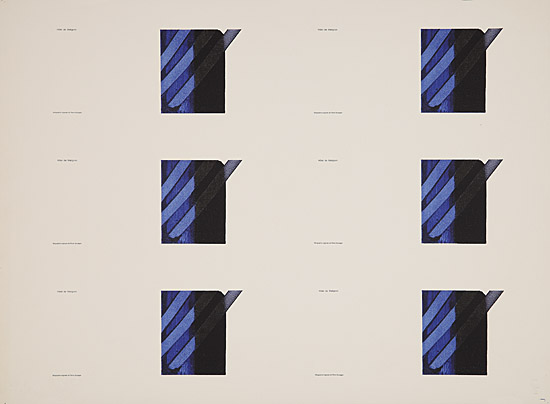
Pierre Soulages
(Rodez 1919 - 2022 Nîmes)
"Sérigraphie No. 17"
6 Grußkarten auf einem Bogen
Farbsiebdruck 1989
55,9 x 75,9 cm, Abb. 11,5 x 11,3 cm
Encrevé/Miessner Kat. Nr. 109
[25316]
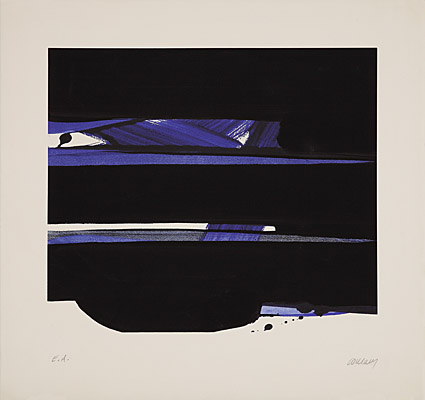
Pierre Soulages
(Rodez 1919 - 2022 Nîmes)
"Sérigraphie No. 20"
Farbsiebdruck 1991
57,5 x 60,8 cm, Abb. 40 x 47 cm
sign. bez.
Auflage 125 Exemplare
Encrevé/Miessner Kat. Nr. 112
[24905]
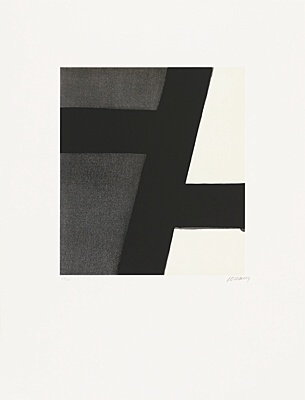
Pierre Soulages
(Rodez 1919 - 2022 Nîmes)
"Sérigraphie No. 21"
Farbsiebdruck 1994
76 x 57,9 cm, Abb. 39,5 x 35 cm
sign. num.
Auflage 110 Exemplare
Encrevé/Miessner Kat. Nr. 113
[22671]
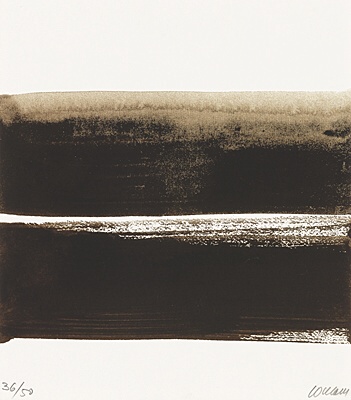
Pierre Soulages
(Rodez 1919 - 2022 Nîmes)
"Sérigraphie No. 23"
im Buch "Soulages - La lumière et l'espace" (Nathalie Reymond)
Buch mit 1 Farbsiebdruck 1999
24,5 x 21,5 cm, Abb. 15 x 21,5 cm
sign. num.
Auflage 70 Exemplare
Encrevé/Miessner Kat. Nr. 115
[17397]
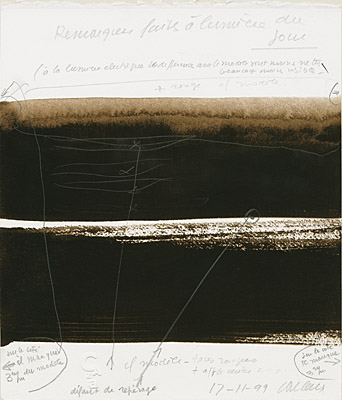
Pierre Soulages
(Rodez 1919 - 2022 Nîmes)
"Sérigraphie No. 23"
aus dem Buch "Soulages - La lumière et l'espace" (Nathalie Reymond)
Farbsiebdruck 1999
24,5 x 21 cm, Abb. 15 x 21 cm
sign. dat.
Auflage 70 Exemplare
Encrevé/Miessner Kat. Nr. 115
Arbeitsexemplar des Druckers mit handschriftlichen Anmerkungen von Pierre Soulages.
[25127]

Pierre Soulages
(Rodez 1919 - 2022 Nîmes)
"Sérigraphie No. 27"
Farbsiebdruck 2003
30 x 22 cm, Abb. 22 x 14,7 cm
sign. bez.
Encrevé/Miessner Kat. Nr. 119
[25128]
Pierre Soulages
(Rodez 1919 - 2022 Nîmes)
"Sérigraphie No. 30"
Farbsiebdruck 2008
65 x 65 cm, Abb. 51 x 50,3 cm
sign. num.
Auflage 67 Exemplare
Encrevé/Miessner Kat. Nr. 122
[21921]
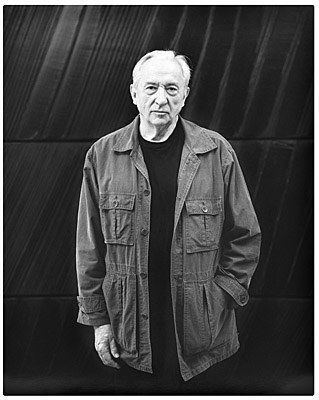
Pierre Soulages in seinem Atelier, Paris 1999
© photo : Fritz Pitz / musée Soulages, Rodez
Pierre Soulages stands among the most renowned and significant French painters of the 20th and 21st century.
As a prominent representative of the École de Paris and the informal art movement during the 1950s and 1960s, Pierre Soulages now ranks among the world's foremost proponents of abstract art.
He drew inspiration from sources such as Romanesque church architecture and cave paintings, notably those found in his hometown of Rodez in Southern France. The distinctive landscape, architecture, stone, and light of his native Aveyron region have profoundly influenced Soulages's artistic direction.
Soulages has long been captivated by light. He extracts it from blackness: "Black is a color of light. Through its absorption and reflection, it establishes contrasts. Birds create music, while humans engage in painting. The sole creature that paints is man. For millennia, humans have painted – often in black!" His visual language is remarkably stripped down. Techniques have evolved, with periods of using oil paint, walnut ink, tar, or acrylic; however, the pursuit of light remains constant.
It is now universally acknowledged that Pierre Soulages's graphic works, characterized by a remarkable authenticity of expression, occupy a singular position in European art. He began his graphic exploration with the technique of etching. In his creative process, he allowed ample space for the unexpected and chance: "Because these accidents open up unforeseen possibilities, an unknown realm where one undertakes great risks, risking getting lost." Few graphic artists inclined towards experimentation have engaged with the copper plate to the extent that Pierre Soulages has.
Soulages also delved deeply into the technique of lithography. His approach was highly innovative, and he was willing to chart new paths in stone manipulation. Each edition reflects the artist's original identity. This same high level of recognizability in his artistic signature characterizes the screen prints that Pierre Soulages began producing in 1972.
His graphic oeuvre, encompassing etchings, lithographs, and screen prints, is both scarce and marked by a high degree of technical finesse and innovation. The motifs embody a symbiosis of color, paper, and form, thus positioning his graphic works as a distinct body of work that stands in parallel to his painting oeuvre.
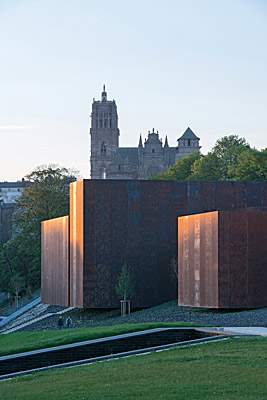
Musée Soulages, Rodez © RCR arquitectes.
© photo : Pep Sau / musée Soulages, Rodez
| 1919 | Geboren am 24. Dezember in Rodez (Departement Aveyron, Südfrankreich). |
| 1938 | Ein Klassenausflug zur Abtei Conques weckt sein Interesse für romanische Kunst. Ebenso faszinierend sind für den jungen Pierre die Menhir-Statuen im Musée Fenaille in Rodez, die ihn neben seiner Mitarbeit an Ausgrabungen mit der vorgeschichtlichen Kunst in Berührung bringen. |
| 1939 | Für einige Monate Aufenthalt in Paris. Häufiger Besuch im Louvre. Ausstellungen von Cézanne und Picasso wecken sein Interesse. Er bewirbt sich an der École Nationale des Beaux-Arts, erhält eine Zusage, beschließt aber - wegen unterschiedlicher Auffassungen zum Unterricht - dort nicht zu beginnen und kehrt bei Kriegsausbruch nach Rodez zurück. |
| 1940 | Militärdienst in Bordeaux und Nyons. |
| 1940-45 | Während der deutschen Besetzung hält er sich in Montpellier auf und studiert an der École des Beaux-Arts. Besuche im Musée Fabre. Er arbeitet als Weinbauer. Er lernt Colette Llaurens kennen, die er 1942 heiratet. Nachdem Montpellier ebenfalls von der Wehrmacht besetzt wird, taucht Soulages unter, um der Zwangseinberufung zum Arbeitsdienst nach Deutschland zu entgehen. Begegnung mit dem Dichter Joseph Delteil, der ihm Sonia Delaunay vorstellt. |
| 1946 | Lässt sich nach dem Krieg in Courbevoie in der Nähe von Paris nieder und widmet sich ausschließlich der Malerei. Er beginnt Leinwände in überwiegend dunklen Farben zu malen. Erste Ausstellungsbewerbungen stoßen auf Ablehnung. |
| seit 1947 | Freundschaft mit Férnand Leger, Francis Picabia und Hans Hartung. Seine ersten von Schwarz beherrschten Gemälde werden im Salon des indépendants ausgestellt. Er malt mit Nussbeize. |
| 1948 | Umzug nach Paris. Beteiligung an der wegbereitenden Wanderausstellung "Französische Abstrakte Malerei" in den Museen von Stuttgart, München, Düsseldorf, Hannover, Frankfurt, Wuppertal und Kassel. Im selben Jahr besucht ihn der Leiter des New Yorker Museum of Modern Art, James Johnson Sweeney und erwirbt eines seiner Nussbeize-Gemälde. |
| 1949-50 | Erste Ausstellungen: Einzelausstellung in Paris (Galerie Lydia Conti) und Gruppenausstellungen in New York (Galerie Betty Parson), London und São Paulo. Entwirft die Theaterdekoration für "Héloise et Abélard" von Roger Vaillant im Théâtre des Mathurins, Paris. Bis 1952 folgen noch drei weitere Theaterprojekte. |
| 1951-56 | Erste Radierungen im Atelier Lacourière entstehen (1952). Beteiligung an Ausstellungen im Ausland: Galerie Birch in Kopenhagen (1951), "Advancing French Art" The Phillips Gallery Washington (1951), "Younger European Painters" Guggenheim Museum New York (1953), "The New Decade" Museum of Modern Art New York (1955) sowie Museen in Minneapolis, Los Angeles und San Francisco. Erste documenta in Kassel (1955). |
| 1957 | Bezieht ein neues Atelier in Saint-Julien-Le-Pauvre und beginnt in den Ateliers Lacourière und Mourlot mit dem Druck einer neuen Serie von elf Radierungen und sieben Lithographien. Reise in die USA. Kontakt mit Willem de Kooning, Mark Rothko, Robert Motherwell. Im selben Jahr wird er mit dem Grand Prix der Biennale von Tokio geehrt. Seine Druckgraphiken werden erstmals in der Pariser Galerie Berggruen gezeigt. Im Jahr darauf Ausstellungen in den Galerien Gerd Rosen (Berlin) und Gimpel Fils (London). |
| 1958 | Reisen nach Kambodscha, Thailand und Japan, wo sein Interesse für die Kalligraphie geweckt wird. |
| 1959 | Soulages lässt auf den Hügeln von Sète ein Haus mit Atelier bauen, in dem er künftig einen Teil des Jahres verbringt. Grand Prix der II. Internationalen Graphikbiennale, Ljubljana. |
| 1960-61 | Erste Retrospektiven: Kestner-Gesellschaft (Hannover) und Museum Folkwang (Essen). Anlässlich der IV. Internationalen Graphikbiennale stellt die Moderna Galerija Ljubljana Werke von ihm aus. Im Herbst 1961 Aufenthalt in Mexiko. |
| 1962-63 | Neue Druckgraphiken bei Ausstellungen in Jugoslawien (Museum für bildende Kunst Zagreb, Universität von Novi Sad). Retrospektive "Soulages. Malerie og Raderingen" (Ny Carlsberg Glyptotek, Kopenhagen). |
| 1964 | Mitwirkung an der "documenta III" und an der Ausstellung "Painting and Sculpture of a Decade 54-64" (Tate Gallery, London). Auszeichnung zusammen mit Jean Arp: Carnegie International Prize, Pittsburg. In Aubusson lässt er in den Ateliers Pinton Wandteppiche fertigen. |
| 1966-68 | Weitere Werkschauen, darunter im Museum of Fine Arts in Houston (1966), wo Soulages seine Gemälde erstmals an Stahlkabeln aufspannen lässt. Anfertigung eines Wandgemäldes aus Keramik (mit dem Atelier Mégard) für ein Bürohochhaus in Pittsburgh (1968). |
| 1970-71 | Neue Ausstellung von Druckgraphiken (Galerie Jobbé-Duval, Rennes). Auszeichnung mit dem Grand Prix der Graphikbiennale Oslo. |
| 1972-74 | Werkschau in Washington (1972) und Wanderausstellungen in Charleroi, Aalborg und Neuchâtel (1973). 1974 schließt er eine weitere Serie von zehn Radierungen und acht Lithographien ab. Im selben Jahr erscheint im Verlag Yves Rivière ein Band über sein graphisches Werk: "Soulages. Eaux-fortes et lithographies". Die Galerie de France, die Librairie La Hune und die Maison des Arts in Montbéliard zeigen seine Druckgraphiken. Die Wanderausstellung "Soulages. Peintures et gravures" ist in Dakar, Madrid, Lissabon, Montpellier, Mexico, Rio de Janeiro, São Paulo, Caracas und Maracaibo (1974-1976) zu sehen. |
| 1975 | Soulages erhält den Prix des Arts der Stadt Paris und beginnt mit der Arbeit an drei Bronzeplastiken, die sich an seinen Radierungen inspirieren. |
| 1976 | Retrospektive im Musée d'art et d'industrie in Saint-Étienne. Rembrandt-Preis, Hamburg. |
| 1978 | Ausstellung "Bronzes et gravures de Pierre Soulages" in Vallauris und Doorn. |
| 1979-80 | Soulages wird Ehrenmitglied der American Academy of Arts and Letters. Jüngere Werke (1979-1980) im Musée National d'Art Moderne – Centre Georges Pompidou, Paris und Musée de la Boverie, Lüttich. Retrospektive im Künstlerhaus Salzburg. |
| 1981-82 | Weitere Retrospektiven in Aarhus, Esbjerg und Kopenhagen. Die Galerie Hans Ostertag (Frankfurt) und das Alte Schloss (Gießen) stellen seine Druckgraphiken aus. |
| 1984-85 | Retrospektiven im Seibu-Museum in Tokio (1984) sowie in Den Haag (1985). |
| 1986 | Grand prix national de peinture, Paris. |
| 1987 | Erhält den Auftrag für die Gestaltung der 104 Glasfenster der Abteikirche Sainte-Foy in Conques. Fertigstellung 1994. |
| 1988-89 | Ausstellung "Pierre Soulages. Radierungen 1952-1988" in Reykjavik und Neuburg an der Donau (D). Druckgraphiken von Soulages sind in Algier, Karthago, Athen, Malta, Buenos Aires, Córdoba und Santa Fe zu sehen. 1989 zeigen das Museum Fridericianum Kassel, das IVAM Instituto Valenciano de Arte Moderno Centre Julio González in Valencia und das Musée des Beaux-Arts in Nantes die Retrospektive "Soulages. Quarante ans de peinture". |
| 1991-92 | In dieser Zeit werden Soulages zwei Ausstellungen gewidmet - die erste in Terrassa, Huesca, Saragossa, Málaga, Salamanca, Vigo, Bilbao, La Coruña, Gijon, Avilés, Mallorca, Sa Pobla und Granollers, die zweite in Tokio. 1992 erhält er in Japan zusammen mit Frank Gehry und Akira Kurosawa den angesehenen Preis Praemium Imperiale. |
| 1993-94 | Das Nationalmuseum für zeitgenössische Kunst Seoul widmet Soulages eine Werkschau, die ebenfalls in Peking und Taipeh zu sehen ist. 1994 erscheint der erste Band des dreibändigen Werkverzeichnisses "Catalogue raisonné de l'œuvre peinte de Soulages" von Pierre Encrevé im französischen Seuil-Verlag. |
| 1995 | Soulages' Druckgraphiken werden im Centre culturel François Mitterrand in Beauvais gezeigt. |
| 1996 | Retrospektive Soulages. "Noir-Lumière" im Musée d'Art moderne de la ville de Paris, im Musée des Beaux-Arts de Montréal und im Museu de Arte São-Paulo. Der zweite Teil des Catalogue raisonné erscheint. |
| 1997 | "Pierre Soulages, l'œuvre gravé" in der Galerie l'Espace 13, Aix-en-Provence. |
| 1998 | In diesem Jahr erscheint der dritte Band des Catalogue raisonné von Pierre Encrevé. |
| 2001 | Soulages stellt als erster lebender französischer Künstler in der Sankt Petersburger Eremitage aus. |
| 2002 | "Soulages. Eaux-fortes et bronzes" im Musée Rignault, Saint-Cirq-Lapopie. |
| 2003 | "Soulages. L'œuvre imprimé" in der Bibliothèque Nationale de France, Paris. |
| 2004-05 | Ausstellung Pierre Soulages, Gustave Le Gray im Pariser Musée d'Orsay. 2005 stiftet Pierre Soulages der Agglomeration Grand Rodez 250 Gemälde auf Leinwand und Papier, Druckgraphiken und Bronzearbeiten. Diese Schenkung bildet den Grundstock des künftigen Musée Soulages in Rodez. |
| 2006 | Ausstellung "Pierre Soulages. Painting the light", Sammlung Essl, Klosterneuburg-Wien (Ö) Österreichisches Ehrenzeichen für Wissenschaft und Kunst. |
| 2007 | Das Musée Fabre in Montpellier würdigt ihn mit einem ständigen Saal, der 20 Gemälde (1951-2006) zeigt. Prix Julio González, Spanien |
| 2008 | Das katalanische Architektenbüro RCR erhält den Zuschlag für den Bau des Musée Soulages in Rodez. |
| 2009 | Anlässlich seines 90. Geburtstages würdigt das Pariser Centre Georges Pompidou ihn mit einer großen Retrospektive. |
| 2014 | Das Musée Soulages in Rodez wird im Mai eröffnet. |
| 2015 | Pierre Soulages erhält das Großkreuz der französischen Ehrenlegion. Der 4. Band des Werkverzeichnisses "Soulages, vollständiges Werk: Gemälde" von Pierre Encrevé erscheint |
| 2019 | Pariser Louvre würdigt den Künstler zum 100. Geburtstag mit einer Ausstellung im prachtvollen "Salon carré" im Musée du Louvre. Auch das Centre Pompidou zeigt seine Arbeiten in einer Einzelaustellung. Zu Ehren zum 100. Geburtstag viele Veranstaltungen in Frankreich und im Ausland, begleitet von zahlreichen Buchveröffentlichungen, Radio- und Fernsehsendungen. |
| 2022 | Pierre Soulages stirbt im Alter von 102 Jahren in Nîmes. Am 2. November fand eine nationale Ehrung im Cour Carrée des Louvre in Paris unter der Leitung von Präsident Emmanuel Macron statt. |
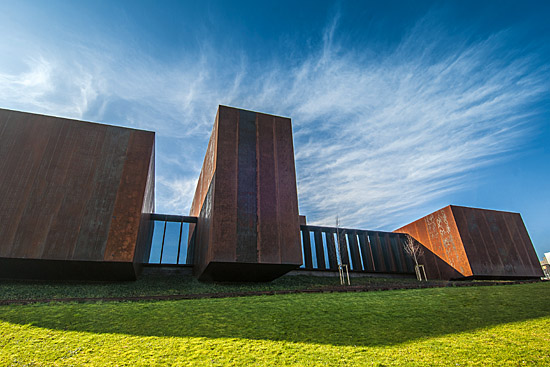
Ansicht Nordseite des musée Soulages, Rodez © RCR arquitectes.
© photo : A. Meravilles / musée Soulages, Rodez
| 1949 | Galerie Lydia Conti, Paris |
| 1951 | Galerie Birch, Kopenhagen |
| 1952 | Galerie Stangl, München |
| 1954 | Kootz Gallery, New York Arts Club, Chicago |
| 1955 | Gimpel Fils Gallery, London Kootz Gallery, New York Rodgers University, New Brunswick |
| 1956 | Galerie de France, Paris Kootz Gallery, New York |
| 1957 | Galerie Berggruen, Paris Kootz Gallery, New York |
| 1959 | Kootz Gallery, New York |
| 1960 | Galerie de France, Paris Kestner Gesellschaft, Hannover |
| 1961 | Museum Folkwang, Essen Gemeente Museum, Den Haag Kunsthaus, Zürich Kootz Gallery, New York |
| 1962 | Massachusetts Institute of Technology, Boston |
| 1963 | Galerie de France, Paris Ny Carlsberg Glyptotek, Kopenhagen |
| 1964 | Kootz Gallery, New York |
| 1965 | Kootz Gallery, New York |
| 1966 | Museum of Fine Arts, Houston |
| 1967 | Gimpel und Hanover Galerie, Zürich Gimpel Fils Gallery, London Musée National d'Art Moderne, Paris Galerie de France, Paris |
| 1968 | Gründung des Crédit Lyonnais Ausschuss Paris Knoedler Gallery, New York Museum of Art, Pittsburg Albright-Knox Art Gallery, Buffalo Musée d'Art Contemporain, Montreal Museum of Quebec, Quebec |
| 1972 | College Park Gallery, University of Maryland, Washington DC Galerie Protée, Toulouse Galerie de France, Paris Gimpel Fils Gallery, London |
| 1973 | S. Henie-N. Onstad Artsenter, Hovik Odde Nordjyllands Kunstmuseum, Aalborg Radhus Gentofte - Kopenhagen Palais des Beaux-Arts, Charleroi Musée d'Art et d'Histoire, Neuchâtel Gimpel und Hanover Galerie, Zürich |
| 1974 | Atelier des Halles, Paris Maison des Arts, Montbéliard Dynamic Museum, Dakar |
| 1975 | Fundaçao Calouste Gulbenkian, Lissabon Salas del Patrimonio Artistico y Cultural, Madrid Musée Fabre, Montpellier Museu de Arte Moderno, Mexico |
| 1976 | Museo de Bellas Artes, Caraca Museo, Maracaibo Fundaçao Cultural, Brasilia Museu da Universidad São Paulo Museu de Arte Moderna, Rio de Janeiro Musée d'Art et d'Industrie, Saint-Etienne |
| 1977 | Maison de la Culture, Mulhouse Gimpel and Weitzenhoffer Gallery, New York Galerie de France, Paris Galerie de France (FIAC), Paris |
| 1978 | Galerie Ulysses, Wien |
| 1979 | Birch Gallery, Kopenhagen Fondation Veranneman, Kruishoutem MNAM, Centre Georges Pompidou, Paris |
| 1980 | Musée du Parc de la Boverie, Liège Künstlerhaus, Salzburg Gimpel Gallery, New York |
| 1982 | Galerie Ostertag, Frankfurt Oberhessisches Museum, Giessen Galerie Ponce, Mexico Art Building, Aarhus Kunstpavillon, Esbjerg Charlottenborg, Kopenhagen |
| 1983 | Museum Unterlinden, Colmar |
| 1984 | Seibu Museum of Art, Tokyo |
| 1985 | Pulchri Studio, Den Haag |
| 1986 | Galerie Art & Essai, UHB Rennes 2, Rennes Galerie de France, Paris Galerie de France (FIAC), Paris |
| 1987 | Musée Saint Pierre Art Contemporain, Lyon Hans-Thoma Gesellschaft, Reutlingen Galerie Rieder, München |
| 1988 | Galerie Jade, Colmar |
| 1989 | Museum Fridericianum, Kassel IVAM-Centro Julio Gonzalez, Valencia Musée des Beaux-Arts, Nantes Tolarno Galleries, Melbourne Galerie Fandos, Valencia |
| 1990 | Galerie Alice Pauli, Lausanne |
| 1991 | Galerie Jade, International Art Exposition, Chicago Mumok Museum Moderner Kunst Stiftung Ludwig, Wien |
| 1992 | Maison des Arts Georges Pompidou, Cajarc Galerie de France, Paris |
| 1993 | National Museum of Contemporary Art, Seoul |
| 1994 | China Fine Arts Palace (Meschuguan), Peking Fine Arts Museum, Taipei Westfälisches Landesmuseum, Münster |
| 1995 | Fondation Veranneman, Kruishoutem |
| 1996 | Musée d'Art Moderne de la Ville de Paris Museum of Fine Arts, Montreal Museu de Arte, Sao-Paulo Galerie Applicat, Paris Centre d'Art Contemporain, Embrun |
| 1997 | Deichtorhallen, Hamburg Galerie Hans Strelow, Düsseldorl Centro de Congresos y Exposiciones, Zaragoza Galerie d'Art, Espace 13, Aix-en-Provence |
| 1998 | Centro Cultural, Logrono Galerie Frahm, Kopenhagen |
| 1999 | Kunstmuseum, Bern Galerie Rieder, München Musée Fabre, Montpellier |
| 2000 | Galerie Alice Pauli, Lausanne Les Abattoirs, Toulouse |
| 2001 | Museum der Eremitage, St. Petersburg Tretyakov Galerie, Moskau |
| 2002 | Musée Rignault, Saint-Cirq-Lapopie |
| 2003 | Galerie Karsten Greve, Paris Bibliothèque nationale de France, Paris |
| 2005 | Robert Miller Gallery, New York Haim Chanin Fine Arts, New York Trumbull Museum, Howland, Ohio Museum Ordrupgaard, Charlottenlund, Kopenhagen |
| 2006 | Tarbes, Salle d'exposition Carmel Sammlung Essl, Klosterneuburg-Wien |
| 2007 | Prix Julio González, Pierre Soulages à l'IVAM Instituto Valenciano de Arte Moderno |
| 2009 | Galerie Rieder, München Centre Georges Pompidou-MNAM, Paris Galerie Pascal Lansberg, Paris Musée d'art Moderne et Contemporain de la ville de Strasbourg Galerie Boisserée, Köln Cité de l'architecture et du patrimoine, Paris |
| 2010 | Musée Fabre, Montpellier Museo de la Ciudad de México, México Bernard Jacobson Gallery, London Martin-Gropius Bau, Berlin |
| 2012 | Musée des Beaux-Arts, Lyon |
| 2013 | Villa Medici, Rom |
| 2014 | Eröffnung des temporären Ausstellungsraums im musée Soulages in Rodez Galerie Boisserée, Köln |
| 2016 | Picasso-Museum, Antibes |
| 2018 | Museum Ludwig im Deutschherrenhaus, Koblenz musée Soulages, Rodez L'Arc et au Pavillon de l'Industrie, Le Creusot Fondation Pierre Gianadda, Martigny |
| 2019 | Musée Fenaille, Rodez Alisan Fine Arts Central, Hong Kong Musée du Louvre, Salon Carré, Paris Centre Pompidou, Paris |
| 2020 | Museum Frieder Burda, Baden-Baden Espace Lympia, Nizza |
| 2021 | Kunstsammlungen Chemnitz Lévy Gorvy, Palm Beach (FL) |
| 2023 | "Les Derniers Soulages. 2010–2022", musée Soulages, Rodez Galerie Boisserée, Köln |
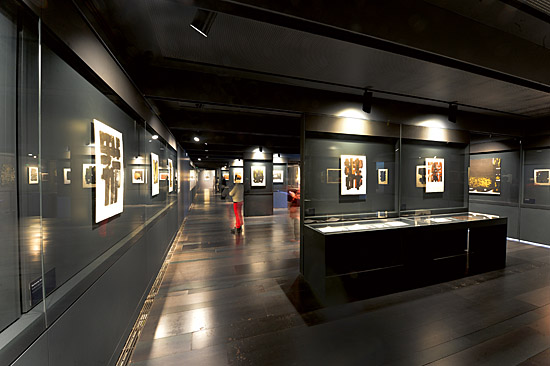
Ausstellungsräume (Graphik) im musée Soulages, Rodez
© photo : Jean-Louis Bories / musée Soulages, Rodez
AUSTRALIEN: Australian National Gallery, Canberra; National Gallery of Victoria, Melbourne; BRASILIEN: Museu de Arte Moderna, Rio de Janeiro; Museu de Arte Contemporanea da Universidad, São Paulo; CHILE: Museo de la Solidaridad Salvador Allende, Santiago; DÄNEMARK: Nordjyllands Kunstmuseum, Aalborg; Musikhuset, Aarhus; Statens Museum for Kunst, Kopenhagen; DEUTSCHLAND: Nationalgalerie, Berlin; Kunsthalle Bielefeld; Kunstsammlung Nordrhein-Westfalen, Düsseldorf; Folkwang Museum, Essen; Hamburger Kunsthalle, Hamburg; Sprengel Museum, Hannover; Staatliche Museen, Kassel; Ludwig Museum im Deutschherrenhaus, Koblenz; Museum Ludwig, Köln; Städtische Kunsthalle, Mannheim; Neue Pinakothek, Bayerische Staatsgemäldesammlung, München; Westfälisches Landesmuseum, Münster; Staatsgalerie, Stuttgart; (Sammlung Domnick), Kunstmuseum, Stuttgart; FINNLAND: Sara Hildén Art Museum, Tampere; FRANKREICH: Musée Picasso, Antibes; Musée de Brou, Bourg en Bresse; Musée des Beaux-Arts, Caen, FRAC Auvergne, Clermont-Ferrand; Musée d'Unterlinden, Colmar; FDAC du Val de Marne, Créteil; Centre régional des Télécomunications, Dijon; Musée des Beaux-Arts, Dunkerque; Musée d'Evreux, Evreux; Musée de Grenoble, Grenoble; Musée Cantini, Marseille; Musées de la Cour d'Or, Metz; FRAC Languedoc-Roussillon, Montpellier; Musée Fabre, Montpellier; Musée des Beaux-Arts, Nantes; Collections publiques, Paris; Musée d'Art Moderne de la Ville de Paris, Paris; Musée National d'Art Moderne, Centre Georges Pompidou, Paris; FRAC Bretagne, Rennes; Musée de la Ville de Rouen, Rouen; Musée d'Art Moderne, Saint-Etienne; Fondation Maeght, Saint-Paul-de-Vence; Les Abattoirs, Toulouse; Musée des Beaux-Arts, Valence; Musée d'Art Moderne, Villeneuve d'Ascq; Musée d'Art Contemporain du Val-de-Marne (MAC/VAL), Vitry-sur-Seine; GROSSBRITANNIEN: The Tate Gallery, London; ISRAEL: The Israel Museum, Jerusalem; ITALIEN: GAM – Galleria Civica d'Arte Moderna e Contemporanea, Torino; JAPAN: Open-air Museum, Hakone; Sezon Museum of Modern Art, Karuizawa; Ohara Museum of Art, Kurashiki; Hara Museum of Contemporary Art, Tokyo; Museum of Modern Art, Toyama; KANADA: Musée d'Art Contemporain, Montréal; Museum of Fine Arts, Montréal; LUXEMBURG: Musée National d'Art, Luxembourg; MAZEDONIEN: Museum of Contemporary Art, Skopje; MEXIKO: Museo Rufino Tamayo, México; NIEDERLANDE: Museum Boymans-van Beuningen, Rotterdam; NORWEGEN: Henie-Onstad Kunstsenter, Hovikodden; ÖSTERREICH: Museum Moderner Kunst Stiftung Ludwig, Wien; Sammlung Essl, Klosterneuburg; PORTUGAL: Centro de Arte Moderna, Fundaçao Calouste Gulbenkian, Lissabon; RUSSLAND: Museum der Eremitage, St. Petersburg; SCHOTTLAND: Scottish National Gallery of Modern Art, Edinburgh; SCHWEIZ: Fondation Gandour pour l'Art, Genève; Musée Cantonal des Beaux-Arts, Lausanne; Kunsthaus, Zürich; SPANIEN: IVAM Instituto Valenciano de Arte Moderno, Valencia; SÜDAFRIKA: Johannesburg Art Gallery, Johannesburg; SÜDKOREA: National Museum of Contemporary Art, Séoul; USA: University of Michigan, Ann Arbor; University Art Museum, Berkely; Indiana University Art Museum, Bloomington; Albright-Knox Art Gallery, Buffalo; Fogg Art Museum, Harvard University, Cambridge, Art Institute, Chicago; Arts Club, Chicago; Cincinnati Art Museum, Cincinnati; Museum of Art, Cleveland; Detroit Institute of Arts, Detroit; Principia College, Elsah (Illinois), Honolulu Academy of Arts, Honolulu, Hawaii; Museum of Fine Arts, Houston; County Museum of Art, Los Angeles; Milwaukee Art Museum, Milwaukee; Walker Art Center, Minneapolis; Yale University Art Gallery, New Haven; Chase Manhattan Bank, New York; Cornell University, Museum of Art, New York; Museum of Modern Art, New York; Solomon R. Guggenheim Museum, New York; Vassar College, New York; The Chrysler Museum, Norfolk; Philadelphia Museum of Art, Philadelphia; University of Pennsylvania, Philadelphia; Museum of Art, Carnegie Institute, Pittsburgh; Art Museum, Princeton; Rhode Island School of Design, Rhode Island; The Aldrich Museum, Ridgefield (Connecticut) ; Washington University Museum, St. Louis; National Trust for Historic Preservation, Tarrytown; National Gallery of Art, Washington; The Phillips Collection, Washington; Worcester Art Museum, Worcester
100. anniversary: Louvre celebrating the artist Pierre Soulages - euronews, youtube.com.